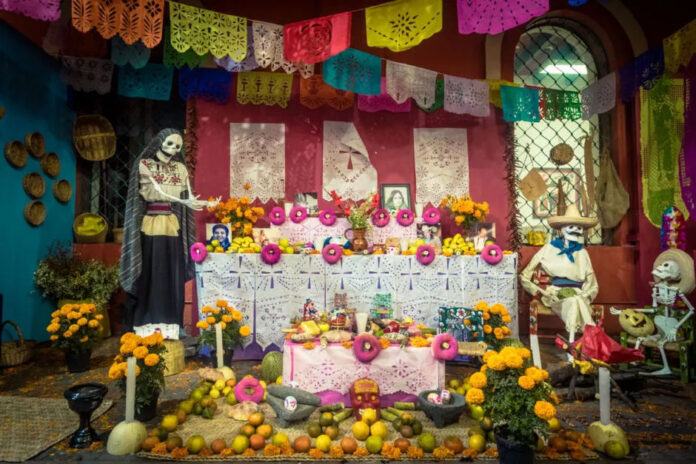by the El Reportero‘s staff
Day of the Dead is a holiday that honors deceased loved ones, deeply rooted in the indigenous cultures of Mexico and Latin America. Over time, this celebration has crossed borders, finding its place in cities like San Francisco and Oakland, where the Latino community has revitalized these ancestral traditions in a diverse urban environment.
Origins and Meaning
Day of the Dead has roots in the pre-Hispanic traditions of the Nahua peoples, such as the Mexicas, who saw death as another phase of the life cycle. Celebrated on November 1 and 2, this holiday allows the living to honor their dead through altars and offerings that include food, flowers, and meaningful objects, believing that the souls of the deceased return to visit them.
With the arrival of the Spanish in the 16th century, the indigenous holiday was mixed with All Saints’ Day and All Souls’ Day, giving rise to a celebration that combines Catholic and indigenous elements.
Celebration in San Francisco
San Francisco, known for its cultural diversity, has been a major center for the Day of the Dead celebration in the United States since the 1970s. The Mission District neighborhood, with a significant Latino population, is the heart of the festivities, which include parades, community altars, and offerings in public places such as Garfield Park.
The most prominent event is “The Procession,” a parade where participants walk in silence, many dressed as calacas (skeletons), carrying candles, cempasúchil flowers, and photos of loved ones. This atmosphere, although festive, is also solemn, offering a space for reflection on death as a part of life.
In Garfield Park, altars created by local families, organizations, and artists are erected. These altars include traditional elements such as candles, photos, and sugar skulls, connecting ancient practices with modern urban life. The traditional music and dances that accompany the festivities reinforce the sense of community and celebration.
Day of the Dead in Oakland
Oakland, another city in the Bay Area, has developed its own version of the Day of the Dead. In the Fruitvale neighborhood, with a vibrant Latino community, the “Day of the Dead Festival” is celebrated, attracting thousands of people annually. This event fuses cultural traditions with contemporary expressions.
The Oakland festival includes live music, folkloric dances, traditional food, and traditional art. What sets this celebration apart is its focus on social justice, as it honors not only deceased loved ones, but also victims of violence and oppression. In recent years, altars dedicated to immigrants, people of color, and other marginalized groups who have lost their lives in unjust circumstances have emerged.
Beyond the religious
Although it has a religious component among Catholics, the Day of the Dead in cities like San Francisco and Oakland has evolved into a more inclusive celebration. People from diverse backgrounds participate in the festivities, valuing both the visual art and the deep cultural significance of the altars and offerings.
This growth has transformed the Day of the Dead into a platform for the expression of identity, resistance and resilience. In these multicultural cities, the holiday allows participants to connect with their roots while reinforcing a sense of community.
The Day of the Dead in San Francisco and Oakland goes beyond a religious holiday; it is a space where life, death, art and culture meet. In these cities, the Mexican tradition has transformed into a diverse celebration that honors the dead and reaffirms the life and identity of a community that continues to evolve.
https://www.youtube.com/watch?v=j44yUsIzUks.



